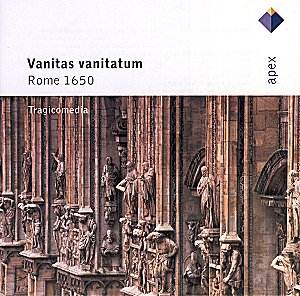
Vanitas
Vanitatum (Vanity of Vanities) - Rome 1650
Giacomo
CARISSIMI (1605-1674)
Vanitas
Vanitatum II
(attrib):
SSATB, 2 violins and basso continuo
1. Simphonia [11'03"]; 2. Hinc, mortales [6'18"]
Marco
MARAZZOLI
(c.1605-1662) Ogni
nostro piacer: SSA, 2 violins and basso continuo - Cantata [13'07"]
Domenico
MAZZOCCHI (1592-1665)
Da
tutti gli horologi si cava moralità: Tenor and continuo (1640) [3'36"]
Luigi ROSSI
(1597-1653)
Ergi la mente al
sole: SSATB, 2 Violins and continuo- Oratorio
1.
Introduttione [4'09"]; 2. Io sono il sole [9'52"]
Virgilio
MAZZOCCHI
(1597-1646)
Sospirate
bellezze: ATB - Madrigal (pub.1652) [2'42"]
Stefano
LANDI (c.1586-1639)
Superbe
colli: Bass and Continuo - Arie (pub.1620) [6'22"]
Luigi ROSSI
O
si quis daret concentum: SSS, solo violin, harp and organ - Motet [7'36"]
ANONYMOUS
Ciaccona
di paradiso, e dell'Inferno: SSATB and Continuo
O che bel star è
star in Paradiso [3'51"]
(from Canzonette spirituali, e morali, Milan 1677)
Passacalli della vita: SA and Continuo
O, come t'inganni [4'26"]
(from Canzonette spirituali, e morali, Milan 1677)
![]() Tragicomedia/Stephen Stubbs
and Erin Headley
Tragicomedia/Stephen Stubbs
and Erin Headley
Recorded in the Doopsgezinde Kerk, Haarlem, The Netherlands, 2/1995
(Re-issue from Teldec 4509-98410-2)
![]() WARNER
APEX 2564 61687-2 [74'00"]
WARNER
APEX 2564 61687-2 [74'00"]
BUY NOW






